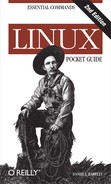This book is a short guide, not a comprehensive reference. We cover important, useful aspects of Linux so you can work productively. We do not, however, present every single command and every last option (our apologies if your favorite was omitted), nor delve into detail about operating system internals. Short, sweet, and essential, that’s our motto.
We focus on commands, those pesky little words you type on a command line to tell a Linux system what to do. Here’s an example command that counts lines of text in a file, myfile:
wc -l myfile
We’ll cover the most important Linux commands for the average
user, such as ls (list files),
grep (search for text in a file),
amarok (play audio files), and
df (measure free disk space). We
touch only briefly on graphical windowing environments like GNOME and
KDE, each of which could fill a Pocket Guide by itself.
We’ve organized the material by function to provide a concise
learning path. For example, to help you view the contents of a file, we
introduce all file-viewing commands together: cat for short text files, less for longer ones, od for binary files, acroread for PDF files, and so on. Then we
explain each command in turn, briefly presenting its common uses and
options.
We assume you have an account on a Linux system and know how to log in with your username and password. If not, speak with your system administrator, or if the system is your own, use the account created when you installed Linux.
